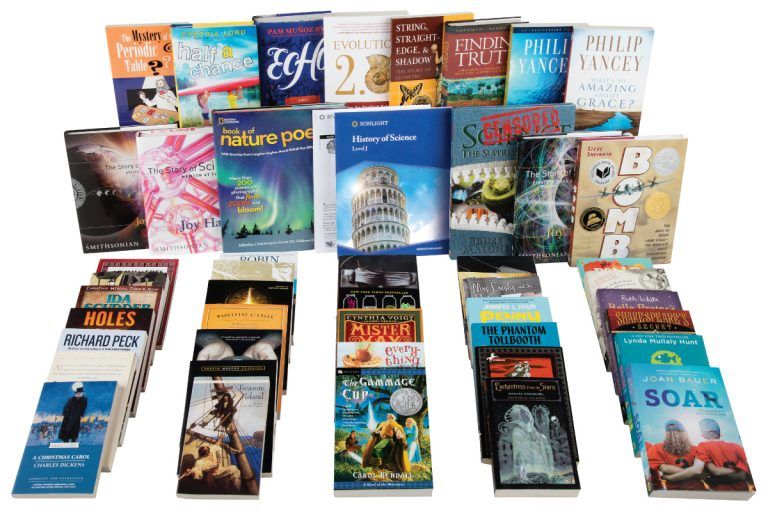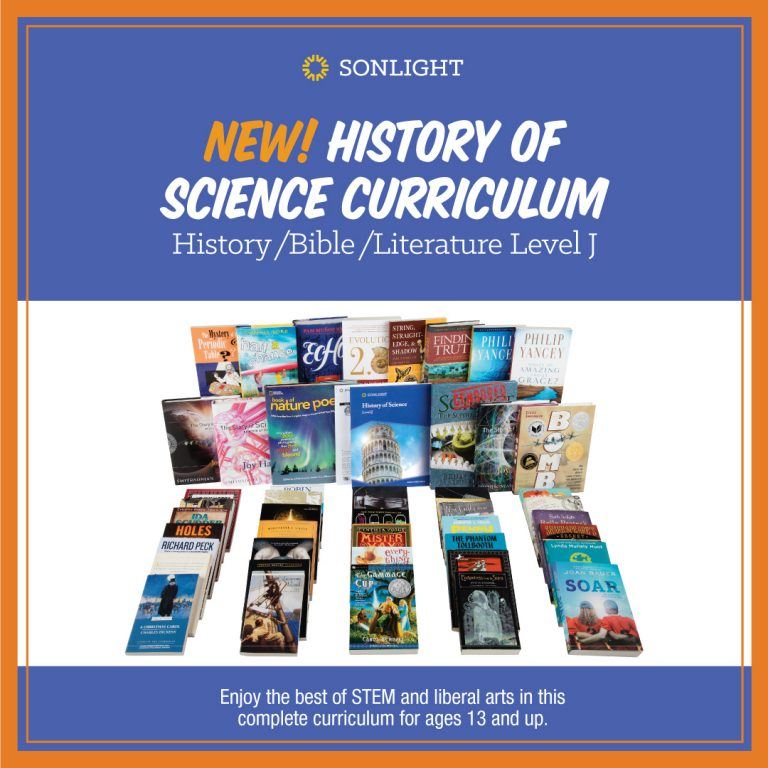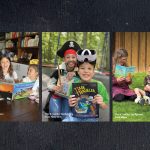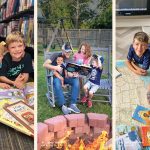
HBL J is designed for students ages 13-15.
Through Sonlight's all new History / Bible / Literature and Language Arts J: History of Science, you'll follow the path of scientific inquiry over the last 4,000 years. This fantastic new program shows you physicists, astronomers, and chemists throughout history as they explore the nature of the world in which we live...and of the universe itself. And it tells the story in Sonlight's signature style: through top-notch, award-winning literature.
When Sarita read through the books, she kept saying, “I am getting so much smarter!” That’s the same feeling you and your children will have, too, as you work through the program:
- When you follow Pythagoras as he proves his famous theorem without using mathematical digits, only clear thinking and a stick in sand.
- Or when you read how the ancients accurately calculated the size of the world using the angle of sunlight in a well on June 21.
- Or when you consider that Newton compared the trajectory of an apple, a small terrestrial object, with the moon, a heavenly body, and wondered if maybe they were both subjected to the same force.
- Or when you accompany Einstein as he does his thought experiments about rockets traveling at near light-speed.
Explore the curiosity, egos, quirks, and flashes of brilliance from 4,000 years of people seeking answers to how the world works. As your students read the stories of how scientists discovered scientific and mathematical laws, they acquire a deeper understanding of scientific concepts in physics, astronomy, and chemistry. And they will be intrigued by fun facts like Tycho Brahe’s metal nose!
The History in HBL J: History of Science
The foundation of the course, the spine, is the three volume set of lavishly illustrated books by Joy Hakim. She obviously loves her subject and does an outstanding job of explaining challenging concepts, finding the fascinating details about the scientists themselves, and keeping the big picture. (It’s a little bit like reading Humans of New York, those shimmering vignettes that compel you to want to keep reading.)
Hakim’s books focus primarily on the advance of scientific thought in physics, especially. This is not the story of biology or geology, but a bit of chemistry and astronomy, along with the study of light, motion, energy, and quantum mechanics. How does the world work?
Of course, that’s not all! In History, you’ll enjoy almost a dozen additional books.
In String, Straight-Edge, and Shadow, you’ll read about the earliest scientists, from unnamed Egyptians through Euclid and their ability to figure out basic math using only the three items in the title:
- the proof of Pythagoras on his basic theorem
- the discovery of the root five rectangle (the Golden Mean) by Eudoxus
- and how, a couple hundred years before Christ, Eratosthenes accurately calculated the size of the world using the angle of sunlight in a well on the summer solstice
These people didn’t have mathematical digit symbols! Can you imagine figuring out these complex proofs without using math, just logic? It’s unbelievable what they were able to reason out!
Moving forward in time a few millennia, in The Clockwork Universe: Isaac Newton, the Royal Society, and the Birth of the Modern Way, the author explains how a science club called the Royal Society changed the way we think of the world. It’s a marvelously entertaining look at the early scientists who went about their scientific enquiry with collaboration and curiosity.
Continuing with nonfiction titles, in The Mystery of the Periodic Table, you’ll read how people looked at the diverse world and put the elements into the clear chart we know today. So much brilliance, to make something as intricate and varied as the world into something as orderly as the Periodic Table!
The thrilling real-life spy story Bomb tells about the race to build—and steal—the world’s most dangerous weapon. It’s a marvelous retelling of the spy network and sabotage teams of the Los Alamos top secret lab and the incredible collaboration behind the first atomic bomb. The countdown to the Trinity explosion is one of the best examples of writing you’ll ever read; you’ll understand why this nonfiction book won the Newbery Medal.
And in Stuff Matters, the author describes ten everyday materials. Here are a few questions he asks and answers:
- What is so special about the experience of eating chocolate?
- How does opaque sand becomes transparent glass?
- How long does it take concrete to dry out (or even if it does)?
This book is an absolute delight!
Biographies in HBL J: History of Science
HBL J, of course, includes several biographies, too. Archimedes and the Door of Science tells about the Greek mathematician. Longitude, by Dava Sobel, tells the story of John Harrison, the man who invented clocks that told precise time at sea—vitally important so that sailors could more accurately plot their location. His development of the chronometer took forty years and a whole lot of tinkering. It’s a great story.
Almost all Sonlight programs include at least one missionary biography, and this one has a an inspiring one!
Ida Scudder, for example, grew up in India, the daughter of missionaries, but she didn’t want to be a missionary and she certainly didn’t want to live in India as an adult. But Ida went to India as a young adult in order to help her sick mother. One night—yes, all in one night—three men came to ask Ida if she would help their wives, all of whom were struggling in labor. Ida’s father was a doctor, but all three men refused the help of Ida’s father. It turned out that they would prefer to let their wives die than break religious taboos against a man seeing a woman in such condition. And, as it turned out, all three wives, and all three babies, did die.
The events of that evening changed Ida’s heart and the course of her life. Ida is nowhere near as well-known as Mother Teresa, but she probably ought to be! But you’ll have to read her biography to find out why.

Enjoy the best of STEM and liberal arts in this complete curriculum for ages 13 and up.
See History / Bible / Literature J
Christian Thought in HBL J: History of Science
Moving from missionary biographies to Christian thought in general, the Hakim books and The Clockwork Universe assume Darwinian evolution is true, with the underlying assumption that no thinking person still believes those silly myths about God. This perspective runs through these books, even though nothing in the books is specifically about evolution. (As previously noted: these books don’t deal with biology.)
And yet, the scientific findings are not so monolithic. Even if Hakim suggests that there is scientific certainty, that is not true—there are other scientific studies, other areas of inquiry, that suggest a different interpretation of the data.
Sonlight’s program includes two such books.
- Censored Science offers a smorgasbord of studies, all of which seem to put holes in the generally accepted model. Author Bruce Malone writes from a Young-Earth Creation point of view. Whatever your current belief about the origins of life, you should find this book interesting, filled with fascinating information and helpful explanations.
- And in Evolution 2.0, we find a different perspective from a different Christian author. Faced with his missionary brother's move toward atheism, author Perry Marshall had to figure out what he really believed about the origin of the earth. This is by far the most technical book in the program, but it is still understandable, filled with important information, thought-provoking and well researched.
The Bible in HBL J: History of Science
Bible J includes daily Bible readings and weekly memory verses scheduled in the Instructor's Guide (IG). Designed to prepare your students for faithfulness in high school and beyond, the program includes Disappointment with God, Finding Truth, and What’s So Amazing About Grace—award-winning books that are beautifully written and a joy to read.
If your students haven’t already experienced some setbacks in life, you know that they will at some point. Philip Yancey’s Disappointment with God takes on the big questions, "Is God unfair? Is God silent? Is God hidden?" He points out that the Israelites in the desert had a fair, vocal, visible God . . . and it didn't help them to live more righteously.
How do you deal with disappointment? Yancey says,
“One bold message in the book of Job is that you can say anything to God. Throw at Him your grief, your anger, your doubt, your bitterness, your betrayal, your disappointment—He can absorb them all. As often as not, spiritual giants of the Bible are shown contending with God. They prefer to go away limping, like Jacob, rather than to shut God out. In this respect, the Bible prefigures a tenant of modern psychology: you can't really deny your feelings or make them disappear, so you might as well express them. God can deal with every human response save one. He cannot abide the response I fall back on instinctively: an attempt to ignore Him or treat Him as though He does not exist. That response never once occurred to Job."
More is going on in the heavenlies than is visible, and we don't know what our faith is doing on a cosmic level, so be faithful. Disappointment with God is an outstanding, helpful book.
Nancy Pearcey’s Finding Truth offers an excellent worldview overview, so that students will be alert and prepared when they come across such views in the world.
And What’s So Amazing About Grace is a book-length treatment of one of the basics of Christianity, something we believers don’t talk about enough. The world can’t duplicate grace, and yet it craves the hope and transformation that grace brings. Explore the church’s great distinctive in action: shocking, scandalous, and amazing.
This is a preparation-for-life Bible program, beautifully written and a joy to read.
The Literature in HBL J: History of Science
The Readers and Read-Alouds for HBL J’s Literature are loosely gathered under the theme “Award-Winning Titles and Authors.”
As you can tell, the History portion of this program is not light reading—it is beautiful and comprehensible but also includes many new, thought-provoking topics and ideas. In order to balance this intensity, the Literature is compelling and interesting, and the Instructor’s Guide is full of excellent discussion questions and introductory literary analysis. These books are not, for the most part, stretching or challenging in the way that, say, Hamlet is stretching and challenging. These are thoughtful books that don’t require slow reading to ensure comprehension. There’s enough of that in the History.
You’ll find a lovely array of genres:
- memoir
- fantasy
- gothic horror (Dr. Jekyll and Mr. Hyde)
- adventure
- survivalist tale
- a Christmas seasonal novel
- sci fi
- dystopian
- mystery
- mythology
- coming-of-age
- historical fiction
- missionary biography
- poetry
You’ll read Newbery Honor and Newbery Medal books, and more titles by authors who have either won those awards or others (like Joan Aiken, author of The Wolves of Willoughby Chase, who won the Guardian Children’s Fiction Prize. This award is given annually, can only be won once per author, and is selected from a panel of British children’s writers. Quite the honor!)
The J Literature is such a good collection!
Add-on Language Arts for J
HBL J does not include—you are not required to purchase—a Language Arts program. However, it has an associated Language Arts Guide that is based on the books in the History/Bible/Literature J program. As in all the other Sonlight middle school LA IGs, you’ll find grammar and mechanics instruction and writing prompts. (There is no separate Parent and Student IG; that structure starts with the 100-level programs.)
Three Goals of Sonlight's History of Science Curriculum: HBL J
We had three goals in mind when creating this program:
- Teach scientific thought to the present.
- Present different perspectives. You don’t need to have all answers now, but know the questions, and engage with a curious mind.
- Prepare a student for further study, equipped with both humility and enthusiasm.
So what do you get in History / Bible / Literature J?
A walk through scientific thought. Various biographies. A spy story. Three different takes on the origin of the earth (standard Darwinian evolutionist, Young Earth Creationist, and a third alternative that uses non-Darwinian evolution to demonstrate God’s greatness). Clear, concise, elegant descriptions, and gorgeous illustrations make this lavish feast for the mind both attractive and understandable.
No other homeschool provider we know of offers a similar program—one that appeals to both STEM-minded students and liberal arts lovers.
When to Use History of Science HBL J
HBL J is intended for students from about age 13 on up. It fits into the Sonlight catalog between H or W and 100—the last program before high school, or an early high school option. In format, it is similar to the other middle school programs, but in content it could work for high school. So HBL J is considered an 8th grade program, but it's flexible enough to use with older students as well.
(Note that Sonlight does not ever plan to release an HBL I. That would be indistinguishable from Roman numeral 1, and sounds vaguely pretentious as well.)
If you have older children, or a well-thought-out plan already, and now you’re wondering how you can possibly fit this program in—here’s an idea: order J and one of the high school literature courses. Do the J Readers and Read-Alouds over the summer, and use the History along with the high school literature program of your choice.
Or order J as a summer program entirely. One of Sarita’s grandsons worked through J History last summer, and the plan is to go through the Literature books he hasn’t yet read over this coming summer.
And Sarita’s daughter can vouch that this is an excellent program for adults, too. If you want to know more about the fascinating history of science, you won’t find a more engaging program out there. It might take you a year or two to read through it yourself, snatching twenty minutes here and there. But it is intellectually satisfying, and, indeed, aesthetically pleasing.
History of Science HBL J is definitely something to think about, and look forward to!
Enjoy the best of STEM and liberal arts in this complete curriculum for ages 13 and up. See History / Bible / Literature J









8 Comments